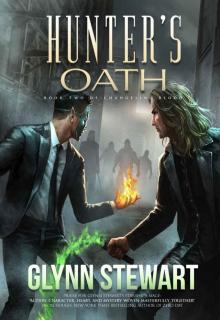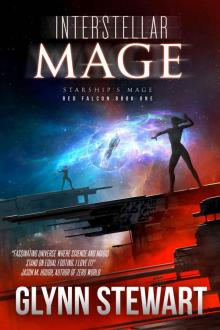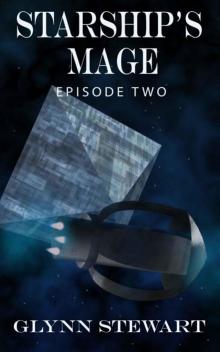- Home
- Glynn Stewart
Raven's Course (Peacekeepers of Sol Book 3) Page 4
Raven's Course (Peacekeepers of Sol Book 3) Read online
Page 4
“You’re late,” she snapped.
“The meeting is scheduled to start in forty-two seconds,” Henry replied precisely. “I am the last of the original attendees to arrive. I am not late.”
He’d tolerate a lot from Admiral Hamilton. She’d sent a medical team to his quarters and ordered him onto medical leave in response to actions that another flag officer might have seen him cashiered for.
The UPSF being what it was, he’d probably have got the medical team at least. She still could have ended his career. She hadn’t.
For that reason alone, Henry Wong would deal with Hamilton’s sharp edges.
“Sit down,” she ordered. “We may as well wait on Xinyi before we get started, anyway. It will be useful to bring her up to speed on our operations before we deal with the scorpion Command sent us.”
Henry swallowed his curiosity with another gulp of coffee as he took his seat across from the Admiral. He traded nods with the other two officers in the room, both Lieutenant Colonels.
Veer Priddy was a native of the Sandoval colony in the Procyon System, a child of the European Union. She was petite, green-eyed and platinum blonde—and the officer who acted as Admiral Hamilton’s whip hand. She was the Peacekeeper Initiative’s operations officer, responsible for making sure their dozen starships ended up where they needed to be when they needed to be there.
Aetius Nicolosi was, despite his name, an American like Henry. He had the swarthy skin and dark eyes of his southern Italian ancestry and he was the yin to Priddy’s yang. Where Priddy was responsible for sending ships out, Nicolosi was, as logistics officer, responsible for making sure they had what they needed to get there and do their jobs.
“That scorpion would be Yellow Bicycle?” Henry asked.
“It would,” Hamilton agreed. “Priddy will update everyone on where we are, and then I will brief everyone on just what Command is doing. It’s the weirdest half-bullshit excuse for giving us what we need without giving us what we want I’ve seen…and I’ve seen sixty years of military bullshit.”
Henry buried his smile beneath more coffee, emptying his mug and setting it down.
“Raven is fully repaired, resupplied and rearmed,” he told the Admiral. “We even have the new starfighters aboard. I’m guessing we’re tasked as a test deployment?”
“If you mean you’re the Force’s guinea pigs, yes,” Hamilton agreed. “Some of the senior officers in FighterDiv are twitchy about giving up their rockets, so the deal was struck that the Initiative would get the first batch of One-Thirties. I figure you’re more likely to end up in a fight than anyone else, so you got them first.
“Jaguar will get her set when she returns from her current sweep. I’m sure Colonel Sharma will appreciate them as much as you do.”
Henry chuckled softly.
“Unlike Colonel Sharma, I could fly one,” he pointed out. “Though if I were to do so in combat, you’d have to cashier me.”
“Yes,” Hamilton said bluntly. “Though you were easier to train that into than some of our other independently deployed battlecruiser skippers.”
She tilted her head as she finished speaking, an unconscious tic that marked her receipt of a message to her internal network.
“Admiral Xinyi is here,” she told the officers. “Let Kukk know if you want something other than coffee, people; it’s time to get to work.”
Admiral Xinyi was a towering woman with heavyset Mongolian features. She took her seat with the careful precision of a large and physically powerful person who didn’t want to break anything.
“I appreciate you joining us, Vice Admiral,” Hamilton said in an unusually soft and courteous tone of voice for her. “While only part of the meeting is going to be immediately relevant to you, I believe you will find the background of our current status useful.”
“Even Vice Admirals jump when full Admirals say tiu,” Xinyi observed calmly. “I am only peripherally aware of the Initiative’s operations, so an updated background briefing will be valuable, given what I understand of Yellow Bicycle.”
Hamilton grunted and gestured to Priddy.
“Lieutenant Colonel, can you update us on the status of the Initiative’s outreach operations and current deployments?”
“Yes, ser,” Priddy confirmed.
Orders from her internal network brought a three-dimensional map of the Ra Sector and the nearest UPA stars up above the table. The Ra Sector, like the other former Kenmiri provinces, was exactly five hundred stars in a roughly cubical region of space.
Its Kenmiri name was completely unpronounceable to humans—and had turned out to be the name of their sun god. Since humanity had labeled the region “Ra” before learning that, Egyptian gods had ended up being the basis of the naming system the UPA used for the provinces.
“In many ways, the Initiative’s current sweep and penetration into the Ra Sector is more complete than our scouting of the region during the war,” Priddy noted. “Our focus then was on routes into the other provinces to make contact with the Vesheron, and on the three Kenmiri colonies themselves.
“We had only visited sixty of the systems in the Ra Sector at the end of the war, designated Ra-One through Ra-Sixty, though we know local names for about half of those stars now.
“Since the formation of the Initiative, we have only visited about forty of the previously scouted systems but have visited just over one hundred new systems,” she continued. “We have made contact with six different industrial-agriworld clusters and twenty-six individual planets, including the Beren homeworld.”
“All of the clusters have made some progress in reestablishing trade links,” Nicolosi added. “The Kenmiri left them no choice, but thankfully, they’ve mostly been more successful than our projections.”
“Which does not mean successful,” Henry said grimly. He’d read the reports.
“No,” Priddy agreed. “We’re looking at around fifty million dead on the worlds we’ve contacted alone since the Kenmiri withdrawal. That’s including deaths in various conflicts over resources, as well as starvation and deaths due to medicine shortages.”
Henry barely managed to conceal a shiver, and the chill in the room was perceptible.
“We cannot take responsibility for that,” Hamilton said bluntly into the room. “I know we can draw a direct line from our actions to the Kenmiri’s to those deaths, but I remind you: we did not set up those clusters and then take away the ships required to keep them running.
“I won’t deny our part of the guilt, nor our guilt in the genocide of the Kenmorad, but we are not responsible for the innocents killed in the systems of the Kenmiri Empire or due to the direct choices of the Kenmiri Remnant.”
Priddy nodded, the Sandovalan officer swallowing hard against the very guilt Hamilton spoke of.
“Of the twenty-six inhabited worlds we’ve contacted, nineteen—including all five worlds of the La-Tar Cluster—now have postal outposts in orbit with skip-drone magazines,” she told them. “Right now, all of those outposts are sending their drones here, which is resulting in a hub-and-spoke model for reliable communications—but those communications exist and have already enabled new deals that have stabilized food supplies in all six of those clusters.”
“Part of the stabilization has also been deals with our own trade cartels and interstellar corporations,” Nicolosi said. “We had some starting difficulties getting our traders and shippers interested in trading outside our borders, but once we were past them, the success of the early ships has resulted in an explosion of interest.”
“We were given a budget for humanitarian operations as well as a budget to provide incentives for people trading with those worlds,” Hamilton said. “I bribed the six largest trade cartels to carry out the first runs, but once they’d made a couple billion apiece, everyone else was suddenly eager to get involved.”
“There may still be excess deaths over what there should be,” Priddy said, her voice sad, “but most of the fundamental shortages are
now under control in the clusters we’re dealing with. Through those clusters, we also now have at least basic intelligence on the remaining systems of the Ra Sector.”
“How many systems are we talking here?” Xinyi asked. “My focus was always on the Kenmiri worlds.”
“Three Kenmiri worlds, eleven five-world dependency clusters, and seven homeworlds,” Priddy reeled off instantly. “We haven’t made direct contact with the Kenmiri worlds or with the homeworlds other than Kozun and Beren. The indirect information we’re receiving suggests much what we expected, though: the homeworlds are fine and the Kenmiri colonies have fallen into the hands of their slave populations.
“In the long term, the Kenmiri colonies may end up being the most successful of the abandoned worlds,” she told them. “They have fully diversified economies and advanced technological industries in a way even the homeworlds don’t.”
The Kenmiri had treated the homeworlds of the various species they’d conquered with relative kid gloves. They’d imposed external rule and harshly punished resistance, but had mostly allowed them to continue with relatively normal, if forcibly insular, economies and societies…except that every few years, the Empire had drafted several million people to help build the agriworlds and industrial planets.
“What’s relevant to today’s discussion is how much of all of that is under Kozun control,” Hamilton interjected. “Rumor tells us that they aren’t the only homeworld to become expansionist in the Ra Sector, just the most aggressive and successful.”
“La-Tar would have been the fourth dependency cluster to fall under their control,” Priddy reported. “The Tak and Sana homeworlds have been conquered by the Kozun as well. Vague rumor, filtered through trade with the Kozun, is that they’re currently at war with an alliance between the Eerdish and Enteni homeworlds.”
“At the same time, they are pressing on at least one other cluster,” Hamilton told everyone. “Admiral Kosigan’s people at Intelligence believe that the Hierarchy has bitten off more than it can chew in multiple directions. Their analysis suggests that the Voices have to be desperate to clarify their borders on at least one side and to find ways to stabilize their existing territory.”
“Meaning that they will likely take Todorovich up on her offer of a conference,” Henry concluded.
“You know Mal Dakis better than anyone else here,” Hamilton pointed out. “Intelligence is basing at least some of that analysis on your own reports on the man.”
Mal Dakis was the First Voice of the Kozun Hierarchy. Now a secular leader and a high priest—theoretically the chosen prophet of the Seven, the Kozun Gods—he had once been a moderately religious but dangerously fanatical Vesheron leader.
And in that role, he’d received support from the UPA battlecruiser Henry Wong had been executive officer of. There were other UPA officers who knew Mal Dakis as well as he did, but he wasn’t sure there were any who knew him better.
“Mal Dakis is…” Henry considered carefully. “Pragmatic. Don’t get me wrong, he believes in his gods. He didn’t declare himself a Voice until his people had already been calling him one for years and he felt he had no choice.
“Everything he has done has been to enhance his power base and to protect the Kozun. He will do whatever he feels is necessary to do both of those things,” Henry said. “He doesn’t care if that is to decimate a planetary population to convince everyone to fall in line…or swallow his pride and negotiate the best surrender he can. Whatever is necessary.”
“That’s Admiral Kosigan’s opinion as well,” Hamilton said. “Which means we are almost certainly going to have that peace conference, which raises the interesting questions that have resulted in the plan for Operation Yellow Bicycle.”
“Does anyone in this room except you know what that means?” Henry asked.
Hamilton laughed coldly.
“Wait a moment, Colonel; I’m getting to the point.”
She took over control of the holographic display and zoomed it in on the vaguely defined crimson area marking the Kozun Hierarchy.
“The Kozun Hierarchy is one of two groups we’ve encountered that deployed disruptor warheads against UPA ships,” she noted. “In both cases, the ship in question was Raven. In the first case, however, the attack wasn’t even in the Ra Sector—but the missiles used at La-Tar show clear development based on the weapons used by the pirates in the Apophis Sector.”
A long finger pointed at the Kozun System, the Hierarchy’s central point.
“Intelligence believes that the Kozun, like those pirates, were provided the disruptor warheads by a third party. Since we do not know where Blue Stripe Green Stripe Orange Stripe has been in the last two years and we know the Drifter Convoys host some of the best research-and-development facilities outside the Kenmiri Remnant…”
She shrugged and bared her teeth in what could charitably be called a smile.
“Command has the Drifters as an aggregate entity as one of the most likely sources for both the disruptor warheads and the stolen grav-shield-penetrator warheads used at the Gathering,” she told them all. “While Blue Stripe Green Stripe Orange Stripe is not at the top of the list for the previous encounters, there is a high likelihood they provided the weapons to the Kozun.”
“But why?” Xinyi asked. “The Drifters underwrote the entire Vesheron war effort.”
“The Drifters were the only non-Kenmiri who were allowed to act as merchants under the Empire,” Henry said quietly. “They knew they were giving up that monopoly by helping destroy the Empire, but that doesn’t mean they’re going to stand aside as our trade cartels muscle their way in. Or anyone else’s, for that matter.”
“Exactly,” Hamilton confirmed. “We believe that the Drifters are attempting to neutralize all potential threats, both direct and mercantile, to the Convoys. Their inability to engage grav-shielded ships is unacceptable to them, so they have found proxies to move against us.
“Which brings us to Yellow Bicycle,” she concluded. “If the Drifters wish to prevent the UPA from expanding our trade routes through the Ra Sector into the Apophis and Hathor Sectors and beyond…they will want us to continue our conflict with the Kozun. Doing so would pin down at least two potential threats to their economic primacy.”
“You think they’re going to use the peace conference as a trap?” Henry asked.
“Admiral Kosigan thinks so, and he managed to get Yellow Bicycle through High Command,” Hamilton told him. “We’re losing Battlecruiser Group Lioness shortly. Her recall orders are already on their way. She’s to return to Base Fallout and join Admiral Xinyi’s command.”
Xinyi nodded confirmation of that. Lioness and her escorts had replaced the battered Raven at La-Tar, standing guard over the UPA’s new ally as the Kozun probed the border.
Now that Raven was back online, recalling her made sense. She’d never been formally assigned to the Initiative.
“Lioness’s status, posted outside the UPA but not part of the Peacekeeper Initiative, appears to have been part of the inspiration for Yellow Bicycle,” Hamilton continued. “We’re not being reinforced, but a carrier group is en route to the Zion System.
“Those ships are being accompanied by a significant logistic detachment and will avoid all contact with inhabited worlds…but will position themselves one skip away from the peace conference,” the Admiral concluded. “Ambassador Todorovich will send her update drones home via the system they are waiting in, and if the Drifters do anything to take advantage of the situation, a fleet carrier and two battlecruisers will be in position to skip to her rescue.”
Henry pursed his lips as he considered the situation. A full carrier group was a powerful force, one capable of engaging entire squadrons of Kenmiri dreadnoughts. If the Drifters didn’t know it was there, the three capital ships and almost two hundred fighters of that group would overwhelm them.
Being a full skip away, though, meant at least a twenty-four-hour turnaround. The Icosaspace Traversal System wasn’t a shor
t-range faster-than-light drive. It could only usefully jump between stars. If the right kinds of stars were in play, the skip length could be as low as eight hours, but they were unlikely to find a link quite so convenient.
“Timing could be tricky,” he warned.
“I know that,” Hamilton agreed. “So does Admiral Kosigan, but it’s the best we can do. We can’t hide a carrier group in the same star system as the conference, after all.”
“I presume Ambassador Todorovich will be attending the conference aboard Raven?” Admiral Xinyi asked.
“That depends on what she negotiates with the Kozun,” Henry admitted. He would prefer to escort the ambassador himself, but he was biased—both in that he believed she’d be safest aboard Raven and in that he wanted to see Todorovich again.
She was a good friend and sounding board, and he missed her.
“Details of the plan will get sorted as we move forward,” Hamilton said. “One key component to all of this is that Carrier Group Scorpius will not be assigned to the Peacekeeper Initiative. The Initiative officers on the scene, whoever they end up being, will operate independently from Commodore Barrie and Rear Admiral Cheung Jian Chin.”
Henry swallowed his emotional reaction to hearing just who their support was going to be. The separation of authority would be important, he supposed, if they put him and Scorpius’s captain in the same star system.
Commodore Peter Barrie, after all, was his ex-husband.
Chapter Six
Henry was pulled into Hamilton’s office when the meeting was over, fresh steaming coffees already waiting on the desk as the doors sealed behind them.
“You going to be trouble?” she asked bluntly.
“Because Peter is in command of my backup?” Henry said. “No. I’m not fond of the idea of calling my ex-husband for help, but I know my damned job, ser.”
“I know. Needed to make sure.” She grunted. “I’m glad to have Scorpius, even with that. A fleet carrier is a fleet carrier right now, but both of her battlecruisers are Corvid-class.”

 Relics of Eternity (Duchy of Terra Book 7)
Relics of Eternity (Duchy of Terra Book 7) Mountain of Mars
Mountain of Mars Wardtown (Teer & Kard Book 1)
Wardtown (Teer & Kard Book 1) Noble's Honor (Changeling Blood Book 3)
Noble's Honor (Changeling Blood Book 3) Raven's Course (Peacekeepers of Sol Book 3)
Raven's Course (Peacekeepers of Sol Book 3) The Service of Mars
The Service of Mars Eyes of Tomorrow (Duchy of Terra Book 9)
Eyes of Tomorrow (Duchy of Terra Book 9) Darkness Beyond (Light of Terra: a Duchy of Terra series Book 1)
Darkness Beyond (Light of Terra: a Duchy of Terra series Book 1) Drifter's Folly (Peacekeepers of Sol Book 4)
Drifter's Folly (Peacekeepers of Sol Book 4) Conviction (Scattered Stars: Conviction Book 1)
Conviction (Scattered Stars: Conviction Book 1) Fortitude (Scattered Stars: Conviction Book 4)
Fortitude (Scattered Stars: Conviction Book 4) Refuge
Refuge A Question of Faith: A Castle Federation Novella
A Question of Faith: A Castle Federation Novella Crusade (Exile Book 3)
Crusade (Exile Book 3) Raven's Peace
Raven's Peace A Darker Magic (Starship's Mage Book 10)
A Darker Magic (Starship's Mage Book 10) Fae, Flames & Fedoras
Fae, Flames & Fedoras Q-Ship Chameleon
Q-Ship Chameleon Duchess of Terra (Duchy of Terra Book 2)
Duchess of Terra (Duchy of Terra Book 2) Sword of Mars
Sword of Mars Rimward Stars (Castle Federation Book 5)
Rimward Stars (Castle Federation Book 5) Q-Ship Chameleon (Castle Federation Book 4)
Q-Ship Chameleon (Castle Federation Book 4) Hand of Mars (Starship's Mage Book 2)
Hand of Mars (Starship's Mage Book 2) Terra and Imperium (Duchy of Terra Book 3)
Terra and Imperium (Duchy of Terra Book 3) UnArcana Stars
UnArcana Stars The Terran Privateer
The Terran Privateer ONSET: To Serve and Protect
ONSET: To Serve and Protect Starship's Mage: Episode 4
Starship's Mage: Episode 4 Operation Medusa (Castle Federation Book 6)
Operation Medusa (Castle Federation Book 6) ONSET: Blood of the Innocent
ONSET: Blood of the Innocent Starship's Mage: Episode 5
Starship's Mage: Episode 5 Hunter's Oath
Hunter's Oath Starship's Mage 2 Hand of Mars
Starship's Mage 2 Hand of Mars Mage-Provocateur (Starship's Mage: Red Falcon Book 2)
Mage-Provocateur (Starship's Mage: Red Falcon Book 2) ONSET: My Enemy's Enemy
ONSET: My Enemy's Enemy Blood Ward
Blood Ward ONSET: Stay of Execution
ONSET: Stay of Execution Mage-Provocateur
Mage-Provocateur Voice of Mars (Starship's Mage Book 3)
Voice of Mars (Starship's Mage Book 3) ONSET (Book 4): Stay of Execution
ONSET (Book 4): Stay of Execution Ashen Stars
Ashen Stars Children of Prophecy
Children of Prophecy Starship's Mage: Omnibus: (Starship's Mage Book 1)
Starship's Mage: Omnibus: (Starship's Mage Book 1) Avalon Trilogy: Castle Federation Books 1-3: Includes Space Carrier Avalon, Stellar Fox, and Battle Group Avalon
Avalon Trilogy: Castle Federation Books 1-3: Includes Space Carrier Avalon, Stellar Fox, and Battle Group Avalon Battle Group Avalon (Castle Federation Book 3)
Battle Group Avalon (Castle Federation Book 3) Stellar Fox (Castle Federation Book 2)
Stellar Fox (Castle Federation Book 2) Starship's Mage: Episode 3
Starship's Mage: Episode 3 Starship's Mage: Episode 1
Starship's Mage: Episode 1 Operation Medusa
Operation Medusa Agents of Mars (Starship's Mage: Red Falcon Book 3)
Agents of Mars (Starship's Mage: Red Falcon Book 3) Hunter's Oath (Changeling Blood Book 2)
Hunter's Oath (Changeling Blood Book 2) Interstellar Mage (Starship's Mage: Red Falcon Book 1)
Interstellar Mage (Starship's Mage: Red Falcon Book 1) Judgment of Mars (Starship's Mage Book 5)
Judgment of Mars (Starship's Mage Book 5) Alien Arcana (Starship's Mage Book 4)
Alien Arcana (Starship's Mage Book 4) Space Carrier Avalon
Space Carrier Avalon Changeling's Fealty (Changeling Blood Book 1)
Changeling's Fealty (Changeling Blood Book 1) Interstellar Mage
Interstellar Mage Stay of Execution
Stay of Execution Starship's Mage: Episode 2
Starship's Mage: Episode 2